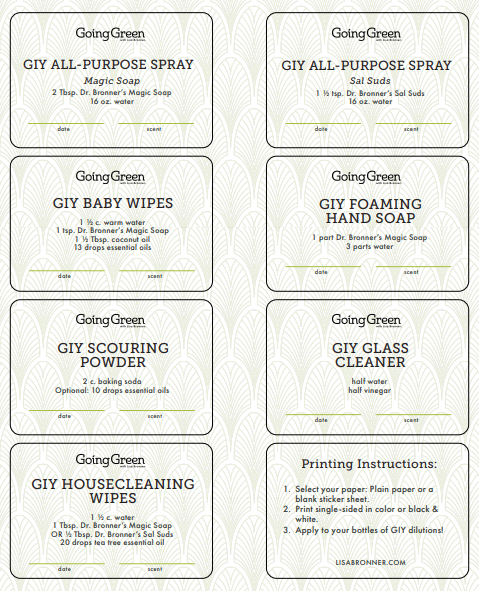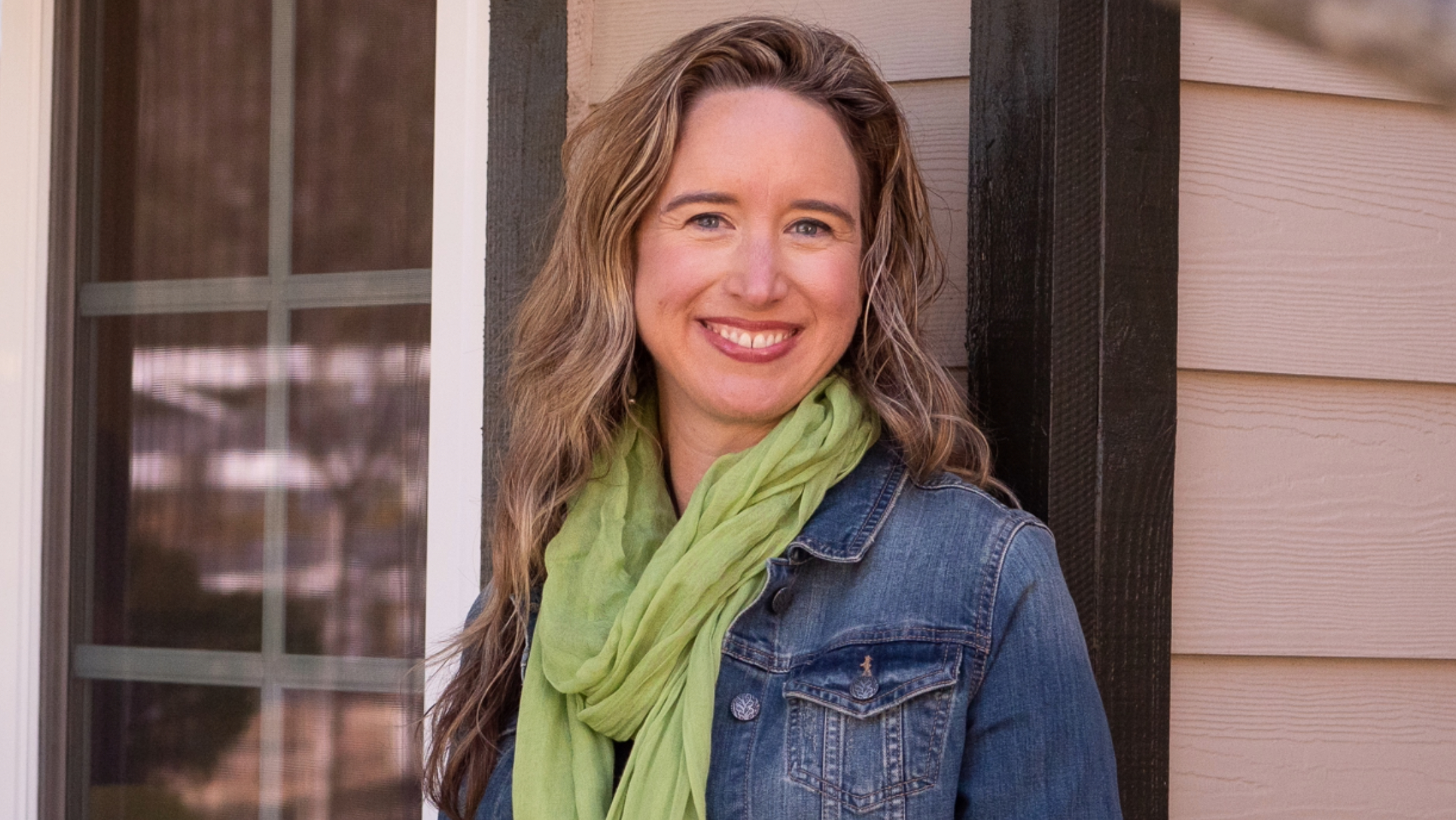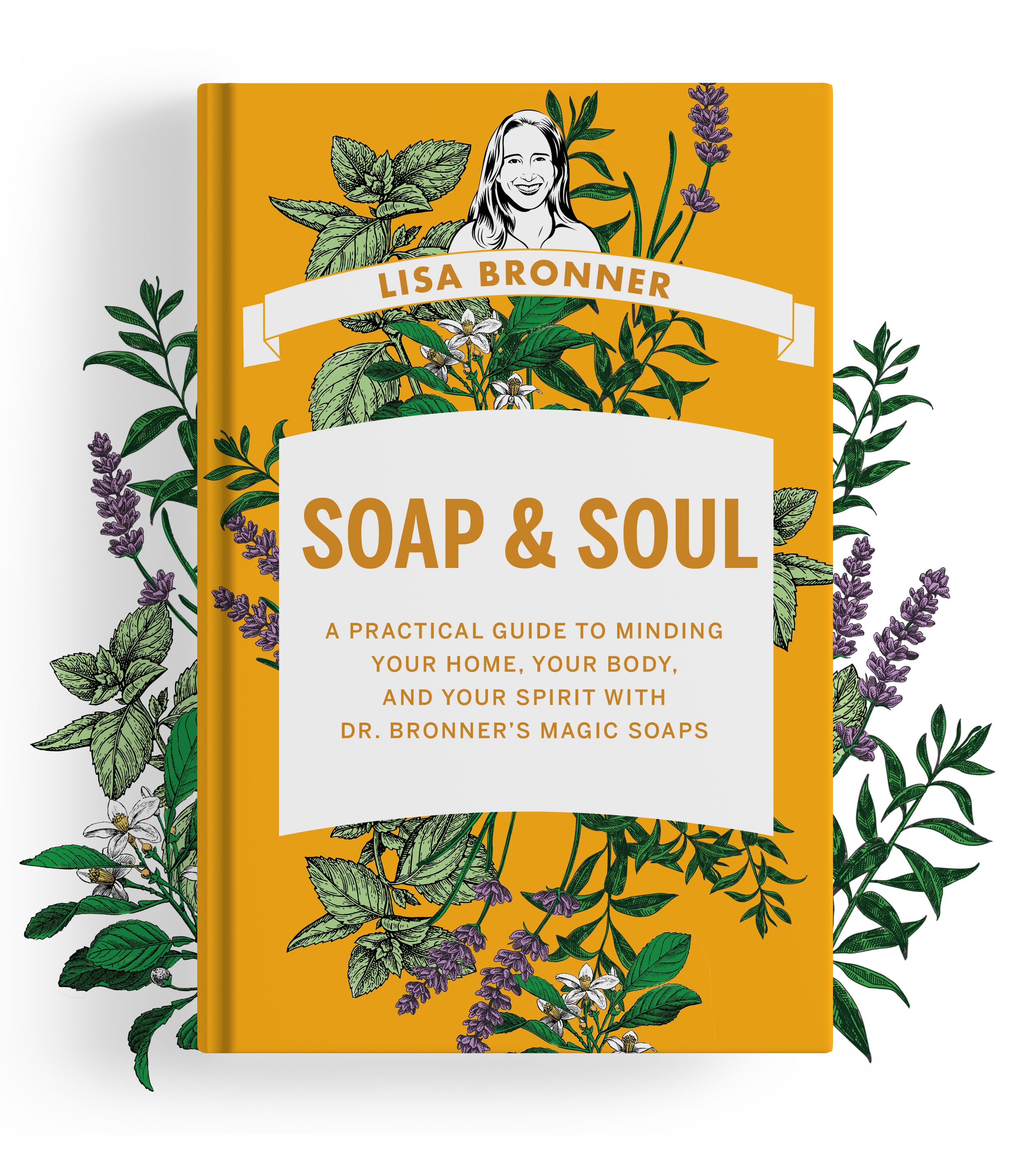
It’s tough to remember my thought-process from 14 years ago. Actually, the concept of “thought process” applying to anything I did 14 years ago is rather far-fetched. Back then, my kids were 1, 5, and 7. Every day was a sprint.
But 2011 was also the year I first used the phrase “Green-It-Yourself,” along with the ever so clever abbreviation “GIY,” in an article I wrote about getting rid of soap scum. I have no idea how I came up with this witticism. Maybe it was a moment of particularly waggish personal brainstorming, or maybe my husband Michael, who is quite savvy at wordplay, suggested it. I don’t think I read it anywhere, since an online search of “green-it-yourself” brings up only two uses that aren’t my own, and both are gardening-focused. In a similar vein, GIY has been used for “Grow-It-Yourself,” a worthwhile endeavor but not the meaning I have for it.
Table of contents
Green-It-Yourself is my expression for DIY recipes
“Green-It-Yourself” and “GIY” are a spin-off of “Do-It-Yourself” and “DIY.” Green-It-Yourself is all about making something on your own without harsh or potentially harmful ingredients. Throughout my Going Green platforms, I use the term GIY to refer to making my own versions of body or cleaning products using simple, low-tox components.
However the phrase came about, it has been part of my own working vocabulary for so long that I frequently forget it’s not widely used elsewhere. (Kind of like those household-isms I forgot to tell my children that we made up. Like saying “changeful” or “vexational” for something that’s bothersome, and then they went and used them at school. Whoops.) My colleagues regularly remind me that I have to say what GIY means.
If you are looking to incorporate more natural cleaning methods or are wanting to use eco-friendly cleaning products, the recipes below are exactly that. But GIY isn’t just for homemade cleaners. It’s also for making your own body care products using plant-based ingredients with a few minerals like baking soda and table salt that add to the fun.
Why I GIY
In my journey of going green, I am GIY-ing my own homemade cleaners and body care products. I value making my own products for a number of reasons:
- I know exactly what’s in these GIY formulations because I make them myself. Lack of transparency is a gripe I have against store-bought formulations.
- GIY recipes pose little hazard if they are spilled or accidentally misused—other than a mess—because they incorporate only a few simple, low-tox ingredients.
- These GIY recipes do not release harmful fumes into the air because the ingredients in my GIY recipes contain low or no VOCs (volatile organic compounds). Airborne particles from conventional cleaning products are a primary cause of indoor air pollution.
- These GIY recipes contain only essential oils for scent, or could be left unscented, and they contain no preservatives. Fragrance and preservative ingredients account for 35 of the 40 most common allergens in cosmetics listed by the FDA. With homemade recipes, I have complete control over what is in my body care and cleaning products.
- Making my own body care products reduces the variety and simplifies the ingredients I put on my skin. The average American uses 12 products daily, averaging 168 unique ingredients, many linked to harmful health effects. Products marketed to people of color consistently contain the most toxic ingredients of all.
- My GIY recipes are almost always cheaper than any formulation you could buy at a store.
- My GIY recipes don’t require a trip to the store because they use a short list of common household ingredients like baking soda, vinegar, sugar, coconut oil, hydrogen peroxide, and water. The only special item to purchase are Dr. Bronner’s Magic Soaps and Sal Suds Biodegradable Cleaner, and I recommend the paper refill carton or gallon size which reduces packaging.
- Making my own cleaners and body care products further reduces packaging because I buy bulk sizes of oft-used ingredients like baking soda and vinegar, and I repurpose mason jars and spice jars for the recipes. I can also refill my Magic Soap and Sal Suds – look for a zero-waste refill center near you. Packaging is often the most environmentally damaging part of the products we use.
- When I make my own cleaners, I make only what I need, how I need it. I can make only a small amount, if it’s for a small need, and then not have a lot left over to store or waste. I can also alter the ratio of ingredients, using perhaps less soap for a lighter job or a little more baking soda for something that needs an extra scrub.
- GIY recipes are fun because I can customize scents using essential oils to match my mood, the season, or the occasion.
GIY recipes to get you started
To make it easy, all of my GIY recipes are gathered together on the GIY category page, but I want to highlight a few in particular. These are the recipes I use and am asked about the most.
GIY body care recipes
- Foaming Hand Soap with Castile Soap – This right here is the single most popular recipe on my blog. Give yourself an easy win by making this right now in a foaming pump.
- Wipe-Off Castile Body Wash Spray – This one was an invention of necessity when my daughter broke her leg. It’s super helpful for anyone unable to take a full shower or bath.
- GIY Baby Wipes – Who am I kidding? These wipes are for so much more than baby, but are handy for cleaning all manner of messes on skin when out-and-about.
- 3 GIY Castile Soap Body Scrubs – Exfoliating soap scrubs keep skin smooth and reduce ashiness. They are endlessly customizable with different scents of soaps and essential oils, plus all the exfoliant options from sugars to salts to coffee grounds
- GIY Coconut Oil Sugar Scrub – Oh my, this one is pure luxury. I make it regularly for myself for softening and nourishing skin, especially for my hands that are prone to cracking in winter weather.
- GIY Lip Scrubs and Tinted Lip Balms – The lip scrubs made with Dr. Bronner’s Virgin Coconut Oil and tinted lip balms made with Dr. Bronner’s Organic Lip Balm make a fantastic lip treat for yourself or gift for a friend, especially if you have teenagers in your life.
- GIY Pet Wipes – Pets have bodies, too! Which is why I put this in body care. With five pets in my house, one of them is always needing to be wiped down on one end or the other, if not all four feet.
GIY home care recipes
- Castile Soap Garden Spray – This combo keeps pests at bay while being gentle on plants, fruits, and veggies.
- GIY Soft Scrub with Dr. Bronner’s – Inspired by a recipe in Karen Logan’s pivotal book Clean House, Clean Planet, the soft scrub is not only fun to make and super useful, but also teaches some valuable lessons in chemistry! Use it to scrub sinks, toilets, tubs or any surface with built up film. It is a slight abrasive, so test the surface in an inconspicuous spot first.
- GIY All-Purpose Cleaning Spray – This is the first GIY recipe I ever made myself. It started me on my journey. Made with Dr. Bronner’s Castile Magic Soap or Sal Suds, this will clean all surfaces from kitchen to bathroom to living spaces to outdoors.
- GIY Housecleaning Wipes – Making your own housecleaning wipes reduces waste and controls the ingredients you’re using on your most oft-touched household surfaces. They’re super easy to whip up!
- GIY Glass Cleaner – There really is no reason to purchase pre-made glass cleaning solutions. This is the simplest GIY recipe of all.
- Scouring Powder – I reach for this scouring powder all. the. time. Sinks, tubs, showers, toilets, and other hard surfaces that need extra scouring. Plus, this doubles as my carpet deodorizer.
Further resources to help you in your GIY journey
Usage & Dilution Cheat Sheets
I have compiled many of these GIY recipes, as well as other ways to use Dr. Bronner’s products into Usage & Dilutions Cheat Sheets based on the Dr. Bronner’s product they feature. On these, you will find things like laundry, dishes, hair masques, and more. They are super handy to download or print out to keep for ready reference:
GIY Recipe Labels
Storebought formulations are easy to identify, even without reading the label because of their intentionally distinctive bottle shapes, formulation colors, and scents. With GIY recipes, you don’t have any of those telltale signs, so be sure to label your recipes.
Here’s a set of handy labels to print out for the recipes that I use the most. These say not only what’s in the bottle, but also what’s needed to refill it. They can be printed on sticker paper or on plain paper. Either way, to keep them legible even if they get wet during use, you may want to print on vinyl sticker sheets (we tested Buttercrafts brand) or tape over them on your container with clear packaging tape.
Green-It-Yourself FAQs
What first step should I take to GIY?
Pick one product that you currently purchase from a store and try to green-it-yourself. Once you’re comfortable with that change, move on to the next product. If you want to start with the easiest recipe, try the GIY Glass Cleaner. Interested in the most popular? Try the Foaming Hand Soap.
How does a DIY recipe differ from a GIY recipe?
While both DIY and GIY are things you make yourself, GIY recipes prioritize the use of common household ingredients to make simple and non-toxic solutions.
What does green cleaning mean?
Green cleaning refers to using methods to clean your home and living spaces that incorporate simple, eco-friendly ingredients; are mindful of the health of people, pets, and plants; leave no residues; and emit no hazardous fumes into the air.
What do I need for green cleaning and other GIY recipes?
Most of the ingredients for my GIY recipes you’ll likely find in your pantry. (That’s another indicator that they are compatible with the body!) I purchase bulk sizes of things like vinegar and baking soda because I use so much of them. The only products that aren’t commonly found in the pantry are hydrogen peroxide and the Dr. Bronner’s Magic Soaps and Sal Suds.
You’ll also need to gather a few containers. It is best not to repurpose containers that previously held conventional cleaning products whose harmful ingredients might have absorbed into the material and then can release back into your GIY formulation. Either purchase new containers, or if you have empty Dr. Bronner’s containers, you can purchase attachments such as sprayers, push/pull lids, or foaming pump tops that repurposes the packaging.
What if I can’t breakup with a particular conventional product?
I get it. It took me a while to let go of my toilet bowl cleaner. We also get really attached to the nostalgia of a product. Scent as well holds powerful associations when it comes to clean. I suggest starting in an area where it’s easiest to make the switch. This will build up your confidence not only in making your own products, but also that they actually work. Eventually, you’ll have such an array of GIY products, it will be easy to give up that last hold-out.
How can I get used to the smell of these homemade products?
Scent is powerful, and it takes a number of approaches to retrain our brain as to what clean smells like. Products you make yourself don’t smell like their storebought counterparts. This is intentional, because the fragrance in conventional products often harbors the most hazards. Here are a few strategies for scent adjusting:
- Get to know essential oils. Find certified organic essential oils and find your favorite scent. Brands often offer scent blends or try the pure scents. One compellingly clean scent combo is tea tree and eucalyptus.
- Turn to something other than cleaning products to make your spaces smell amazing. Try a simmerpot made with oranges, cinnamon, and cloves or cooking something delicious like bread or cookies!
- If there is a bad scent you’re trying to cover up, the source needs to be dealt with. Covering it up won’t work. You will be very glad for the time you took to deal with the cause.
- Lastly, aim to accustom yourself to a less scented environment.
Conclusion
When it comes to my green journey, my foundational motive is to leave the place better than I found it. That means not adding problematic fumes to the air for my family, pets, and myself to breathe in. It also means not leaving residues on surfaces that could rub off on to passing hands or fuzzy paws. It means methods that are as low impact as possible on the world around me, whether we’re considering the formulation we’re using, the production of the ingredients, the packaging, and even the disposal and downstream impact afterwards. These GIY recipes will help you do just that.
These GIY recipes and many more are in my book, Soap & Soul: A Practical Guide to Minding Your Home, Your Body, and Your Spirit with Dr. Bronner’s Magic Soaps, available now in hardback on DrBronner.com or at your favorite bookseller, and as an eBook and audiobook (read by me!) from wherever you download or listen.
Sal Suds cleaner shows >60% biodegradation after 28 days per ISO 14593.



